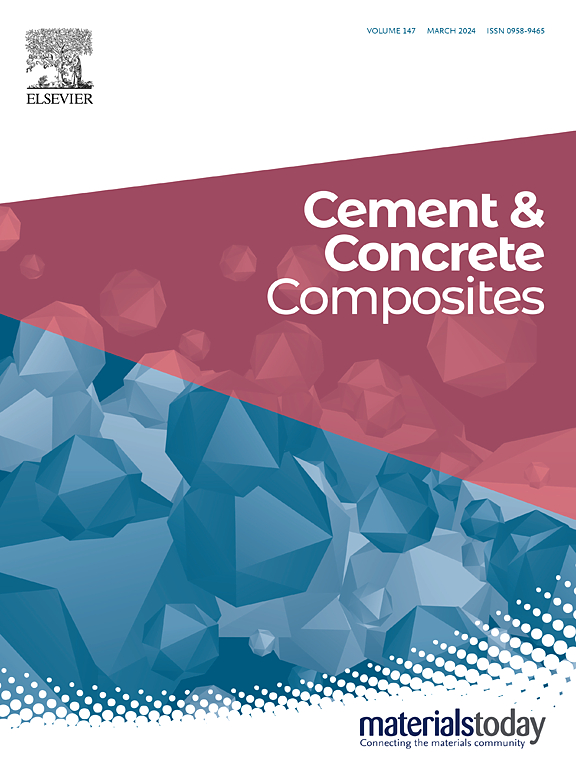高度分散的LDH纳米片对胶凝材料氯离子结合和防腐的影响
IF 13.1
1区 工程技术
Q1 CONSTRUCTION & BUILDING TECHNOLOGY
引用次数: 0
摘要
胶凝材料中自由氯离子的化学结合对延长其使用寿命至关重要,这在很大程度上依赖于铝酸盐水合物,可以通过加入层状双氢氧化物(LDHs)来调节。然而,目前在水泥和混凝土领域合成的LDHs通常存在纳米晶体聚集,限制了其作为纳米填料的潜力,阻碍了氯离子的捕获效率。本研究将含有高度分散的LDH纳米血小板(HDLNPs)的胶凝材料与使用传统LDH粉末(LP)的胶凝材料进行了比较,以揭示离子交换效率依赖的铝酸盐调节和LDH颗粒大小相关的孔隙细化。HDLNPs在早期铝酸三钙(C3A)水化的同时调节硫酸盐与铝酸盐的平衡,促进钙矾石(AFt)相向铝-铁素体-单(AFm)相的转化。此外,由于它们的高分散性,HDLNPs减轻了碳化引起的层间氯结合惰性。然而,HDLNPs主要占据外C-S-H周围的微孔,不能细化毛细孔,这是由于AFt的缺乏而放大的,从而导致毛细吸附率更高。然而,在同等剂量下,HDLNPs在防腐方面优于LP,这激发了LDHs在延迟氯离子进入方面的潜在离子交换能力。掺入LDHs在分散方面的进步强调了它们在设计耐用和可持续胶凝材料方面的重要作用。本文章由计算机程序翻译,如有差异,请以英文原文为准。
Effects of highly dispersed LDH nano-platelets on chloride binding and corrosion protection of cementitious materials
The chemical binding of free chloride ions in cementitious materials, crucial for prolonging their lifespan, relies heavily on aluminate hydrates and can be modulated by incorporating the layered double hydroxides (LDHs). Yet, the currently synthesized LDHs in field of cement and concrete usually suffer from nano crystallites aggregation, limiting their potential as nanofillers and hindering the chloride-capturing efficiency. This study compares the cementitious materials containing highly dispersed LDH nano-platelets (HDLNPs) with those using conventional LDH powder (LP) to unveil the ion-exchange-efficiency-dependent aluminates regulation and particle-size-related pores refinement of LDHs. HDLNPs regulate the sulfate to aluminate balance at a concurrent rate with early-age hydration of tricalcium aluminate (C3A) to promote the conversion from ettringite (AFt) to alumino-ferrite-mono (AFm) phases. Furthermore, due to their high dispersion, HDLNPs mitigate the interlayer inertness toward chloride binding induced by carbonation. However, HDLNPs primarily occupy micropores around outer C-S-H, failing to refine capillary pore, which is amplified by the concomitant AFt shortage, leads to higher capillary adsorption rates. Nevertheless, HDLNPs outperform LP in terms of corrosion protection at equivalent dosage, evoking the LDHs’ unsung ion-exchange capacity in delaying chloride ingress. This advancement in the dispersion of incorporated LDHs underscores their valuable roles in designing durable and sustainable cementitious materials.
求助全文
通过发布文献求助,成功后即可免费获取论文全文。
去求助
来源期刊

Cement & concrete composites
工程技术-材料科学:复合
CiteScore
18.70
自引率
11.40%
发文量
459
审稿时长
65 days
期刊介绍:
Cement & concrete composites focuses on advancements in cement-concrete composite technology and the production, use, and performance of cement-based construction materials. It covers a wide range of materials, including fiber-reinforced composites, polymer composites, ferrocement, and those incorporating special aggregates or waste materials. Major themes include microstructure, material properties, testing, durability, mechanics, modeling, design, fabrication, and practical applications. The journal welcomes papers on structural behavior, field studies, repair and maintenance, serviceability, and sustainability. It aims to enhance understanding, provide a platform for unconventional materials, promote low-cost energy-saving materials, and bridge the gap between materials science, engineering, and construction. Special issues on emerging topics are also published to encourage collaboration between materials scientists, engineers, designers, and fabricators.
 求助内容:
求助内容: 应助结果提醒方式:
应助结果提醒方式:


